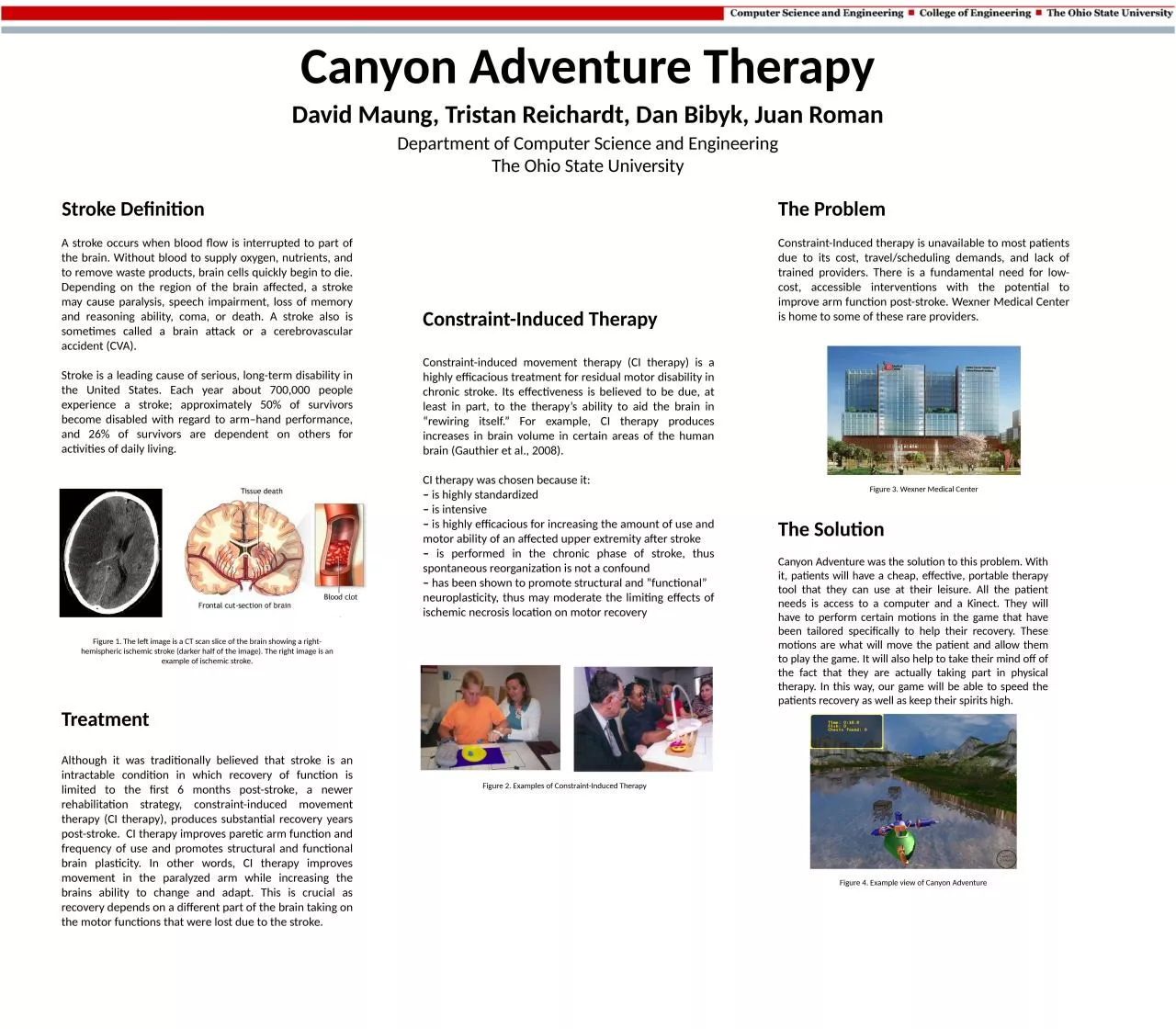

David Maung Tristan Reichardt Dan Bibyk Juan Roman Department of Computer Science and Engineering The Ohio State University The Problem ConstraintInduced therapy is unavailable to most patients due to its cost travelscheduling demands and ID: 999998
Download Presentation The PPT/PDF document "Canyon Adventure Therapy" is the property of its rightful owner. Permission is granted to download and print the materials on this web site for personal, non-commercial use only, and to display it on your personal computer provided you do not modify the materials and that you retain all copyright notices contained in the materials. By downloading content from our website, you accept the terms of this agreement.
1. Canyon Adventure TherapyDavid Maung, Tristan Reichardt, Dan Bibyk, Juan RomanDepartment of Computer Science and EngineeringThe Ohio State UniversityThe ProblemConstraint-Induced therapy is unavailable to most patients due to its cost, travel/scheduling demands, and lack of trained providers. There is a fundamental need for low-cost, accessible interventions with the potential to improve arm function post-stroke. Wexner Medical Center is home to some of these rare providers.Stroke DefinitionA stroke occurs when blood flow is interrupted to part of the brain. Without blood to supply oxygen, nutrients, and to remove waste products, brain cells quickly begin to die. Depending on the region of the brain affected, a stroke may cause paralysis, speech impairment, loss of memory and reasoning ability, coma, or death. A stroke also is sometimes called a brain attack or a cerebrovascular accident (CVA).Stroke is a leading cause of serious, long-term disability in the United States. Each year about 700,000 people experience a stroke; approximately 50% of survivors become disabled with regard to arm–hand performance, and 26% of survivors are dependent on others for activities of daily living.TreatmentAlthough it was traditionally believed that stroke is an intractable condition in which recovery of function is limited to the first 6 months post-stroke, a newer rehabilitation strategy, constraint-induced movement therapy (CI therapy), produces substantial recovery years post-stroke. CI therapy improves paretic arm function and frequency of use and promotes structural and functional brain plasticity. In other words, CI therapy improves movement in the paralyzed arm while increasing the brains ability to change and adapt. This is crucial as recovery depends on a different part of the brain taking on the motor functions that were lost due to the stroke.The SolutionCanyon Adventure was the solution to this problem. With it, patients will have a cheap, effective, portable therapy tool that they can use at their leisure. All the patient needs is access to a computer and a Kinect. They will have to perform certain motions in the game that have been tailored specifically to help their recovery. These motions are what will move the patient and allow them to play the game. It will also help to take their mind off of the fact that they are actually taking part in physical therapy. In this way, our game will be able to speed the patients recovery as well as keep their spirits high.Figure 1. The left image is a CT scan slice of the brain showing a right-hemispheric ischemic stroke (darker half of the image). The right image is an example of ischemic stroke.Constraint-Induced TherapyConstraint-induced movement therapy (CI therapy) is a highly efficacious treatment for residual motor disability in chronic stroke. Its effectiveness is believed to be due, at least in part, to the therapy’s ability to aid the brain in “rewiring itself.” For example, CI therapy produces increases in brain volume in certain areas of the human brain (Gauthier et al., 2008). CI therapy was chosen because it:– is highly standardized– is intensive– is highly efficacious for increasing the amount of use and motor ability of an affected upper extremity after stroke– is performed in the chronic phase of stroke, thus spontaneous reorganization is not a confound– has been shown to promote structural and ”functional”neuroplasticity, thus may moderate the limiting effects of ischemic necrosis location on motor recoveryFigure 2. Examples of Constraint-Induced TherapyFigure 4. Example view of Canyon AdventureFigure 3. Wexner Medical Center